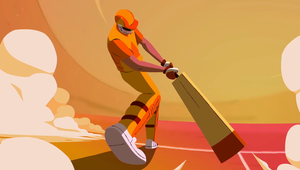
Producing Tomorrow's Producers: Stay Cool, Calm, Collected, and Curious with Ricardo Roberts

Ricardo Roberts was born in the Voz Andes Hospital in Quito, Ecuador. At the time, his American father was a Peace Corps volunteer, and his Ecuadorian mother was the director of an orphanage. In the early 80s the young family eventually made their way to Raleigh, NC where they suddenly had to adapt to a new culture and new language. That move was the start of a fascination with culture and the role media plays in shaping it.
Ricardo’s ultimate goal in life is simple—be a good dad. Listening to music, eating great food, and reading business books like Good to Great and Shoe Dog are what keep him inspired and curious. He also loves traveling, mainly to South America. Favourite MC: Nas. Favourite Movie: City of God. Favourite Food: Ceviche. Favourite City: NYC.
LBB> What advice would you give to any aspiring producers or content creators hoping to make the jump into production?
Ricardo> Find a few (max three) studios you love and do a deep dive into the type of work they create, as well as the creatives and producers doing it. If you haven’t been involved in production before, there are tons of things to learn. It will be helpful to have a jump start on the lingo.
Also, get very familiar with the projects they’re doing. Open up one of the more extensive case studies on their website and find clues. How long did it take? How many people on a project? How many designers, animators, and illustrators were required?
Start following the leads (producers, CDs, ADs, etc.) on social media and get to know them. Then, reach out to make an intro. Some studios have programs like our “Fly on the Wall” initiative, which lets people watch how they do production to learn.
The bonus is that you also get to know people who might want to mentor or hire you in the future. It’s a long-ish process, so give it time and be patient.
LBB> What skills or emerging areas would you advise aspiring producers to learn about and educate themselves about?
Ricardo> I’ll focus on animation and motion design since we do that.
I’d absorb anything and everything producer-related. Chris Do’s 'The Futur' has an excellent course on producing. RevThink, Forum, the Deducers, etc, all have some content about producing. There are so many resources online you can find and teach yourself. Listen to podcasts, etc.
I would also ensure you know the basics: Google Sheets, Slack, Gantt software, task management tools, etc. Focus on getting organised. If you know anyone in the field, try getting your hands on real project calendars, proposals, bids, etc. Expose yourself to the tools early on.
LBB> What was the biggest lesson you learned when you were starting out in production - and why has that stayed with you?
Ricardo> Honestly, it’s being organised and proactive. Great producers anticipate things and have backup plans. And they are extremely detail oriented. If you’re not the most organised or detail-oriented, it will be tough for you.
LBB> When it comes to broadening access to production and improving diversity and inclusion what are your team doing to address this?
Ricardo> We have many initiatives in place to destroy barriers to entry and make our industry more accessible and inclusive.
1. Double the Line. We take a line item in a budget, say, cel animation. We double it and bring on junior, underrepresented talent to shadow senior talent on big jobs. The junor gets to do actual work, not busy tasks that don’t mean shit.
They walk away with a project for their portfolio so that they can say, I worked on this Instagram or Google project, or whatever. We all know you can’t get work without the portfolio, but how do you get that work in the first place? Somebody has to take a risk and give you that shot. Double the Line is one way.
2. Scholarships. In partnership with The School of Motion, we give eight scholarships every year. These students are global, and some of them come from places that don’t even have a banking connection with the outside world (Iran), so even if they had the money to pay for a course, they couldn’t because credit/debit cards don’t work there.
3. Fly on the Wall. This is our flagship program. We bring in anyone (junior, senior, reskillers, upskillers even), and they shadow a specific project, learning how production happens in real time. The good, the bad, the ugly. They see and learn our production process and observe from beginning to end.
How do we create mood boards? What do style frames, sketch storyboards, boardomatics, etc, look like? When do we share with clients? What’s our production timeline? What do client curveballs look like, and how do we handle them? We’ve had over 100 Motion Fliers on projects in 2024, and we’re a 15-person shop. What we love about FOTW is it allows us to impact many more people at a very light lift on our producers.
LBB> And why is it an important issue for the production community to address?
Ricardo> There are many different reasons, but one is that we need diverse perspectives to create impactful work that connects with audience demographics. To do that, you need people with lived experience. People with lived experience wouldn’t have let some of the recent print ad disasters come out that embroil clients in controversy for racial insensitivity. I won’t name names but my god, it’s still happening today. Why?
Another reason is that production is beautiful - why not make it more beautiful by involving new, fresh voices? Who likes monotony and monoculture? I don’t. Brands need to understand that their target audience has changed drastically. If our production community doesn’t include members of this new economy with buying power, they won’t be able to connect. In animation/design specifically, we call this “Design with, not for.”
LBB> There are young people getting into production who maybe don’t see the Line between professional production and the creator economy, and that may well also be the shape of things to come. What are your thoughts about that? Is there a tension between more formalised production and the ‘creator economy’ or do the two feed into each other?
Ricardo> There’s tension. But I see enough room for both content styles. Eventually, content creators and that “Tik Tok” style clients love to ask for will become saturated, and they’ll need to evolve. The same is happening to traditional polished production. I think there’s a balance to be found that brands can get on board with.
LBB> If you compare your role to the role of executive producers when you first joined the industry, what do you think are the most striking or interesting changes (and what surprising things have stayed the same?)
Ricardo> In my shoes, the size of projects has gotten smaller and scrappier. Do more, with less.
Currently, production is very uncertain, and the revenue pie has become considerably smaller. 10 years ago there were more jobs to be had, so pitching and winning is harder. The game is forcing us to push harder, improve, stand out, and find ways to be more competitive. Building personal relationships with people is also more challenging because we Zoom and email all day.
I think what stayed the same is we’re still having fun, doing amazing creative stuff all day, and solving problems 24/7. So, if you enjoy that and are lucky to be a part of it all, you’re in a good spot.
LBB> When it comes to educating producers how does your agency like to approach this?
Ricardo> We have structured onboarding and education processes that we use. We have a set of defined processes that we follow for everything. It’s super important to have that and spend proper time training. Otherwise, you have five producers who do things differently, and that isn’t sustainable or scalable.
LBB> It seems that there’s an emphasis on speed and volume when it comes to content - but to where is the space for up and coming producers to learn about (and learn to appreciate) craft?
Ricardo> Nights and weekends. That’s the only way. Gotta put in the time if you want something. Just ask any athlete. You need to find work-life balance, but you can’t sit back and wait for stuff to happen. It’s hard, I’m afraid to say.
LBB> On the other side of the equation, what’s the key to retaining expertise and helping people who have been working in production for decades to develop new skills?
Ricardo> Have a growth mindset. You have to constantly evolve, learn, grow, and make mistakes. This can be much harder when you’re older and experienced but you really need to devote that time to learning and development.
LBB> Clearly there is so much change, but what are the personality traits and skills that will always be in demand from producers?
Ricardo> Being friendly, cool, calm, collected, curious, detail-oriented, having a good work ethic, being proactive, and being “all in,” ready to do whatever it takes to deliver quality on time and on budget.















